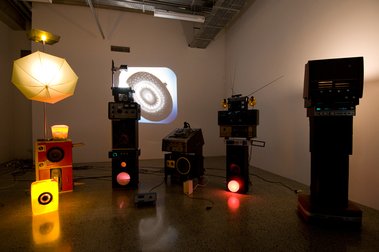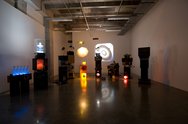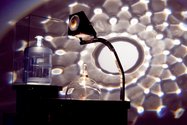John Hurrell – 7 December, 2010
Aurally we are bombarded with three live radio stations and occasional looped sample that randomly turn on and off - as do the blinking lights. It's as if John Cage and Robert Rauschenberg have teamed up with Steven Spielberg and George Lucas. This may be a 'Bricolage Disco' with a twirling acoustic guitar covered with mirror shards, scattering reflected constellations around the walls like a faceted ball in a night club, but there is no way you can dance.
Wade Marynowsky’s interactive installation in St. Paul Street’s Gallery Two is one of those attractive displays that you never want to leave, even though its energetic bursts of programmed light and sound are quite short and you have to immediately rush over to re-enter the door to restart a new variation. Maybe the concentrated but brief intensity creates that impression. Not bad going, considering the raw materials Marynowsky has used were gathered via an emailed appeal for obsolete electronic and electrical gear, sent just before he came over from Sydney for a residency at AUT.
Visually Bricolage Disco presents nine ‘stacks’, made up of suitcases, speakers, sideways stereo cabinets, a reel-to-reel tape recorder, box shelving and other bits and pieces. Heaped up vertically makes them look vaguely robot-like or humanoid.
In a darkened gallery these vertical piles are highly colourful with their blinking glowing lamps and backlit grills. Three overhead projectors cast on three different walls intricate shadowy patterns and swirling lines generated from cutglass fruit bowls or long-necked slender flagons. Other translucent items, like a yellow umbrella and bucket, paper lampshades and a Culbertesque oil container, glow seductively to draw you closer.
These are arranged not as scattered, discrete units spread apart, but as a curved line of stacks that almost merge to become a unified wall.
Aurally we are bombarded with three live radio stations and occasional looped sample that randomly turn on and off - as do the lights. It’s as if John Cage and Robert Rauschenberg have teamed up with Steven Spielberg and George Lucas. This may be a Bricolage Disco with a twirling acoustic guitar covered with mirror shards, scattering reflected constellations around the walls like a faceted ball in a night club, but there is no way you can dance.The work is not interactive in the sense that viewer movement beyond the doorway effects the programme. Once you are inside, it doesn’t matter where you stand.
I’m of the opinion that aural sensations generate deep emotional responses quicker than visual ones, so the broadcasts from randomly tuned radio stations - though non-danceable - have an important role in this work. Even though the overhead projectors with their glass objects make sensationally gorgeous images, completely upstaging the coloured lights and trellised grids, the narratives in news reports or the sweetness of popular tunes hog your attention, and so you try to weave an interpretation pertinent to the moment that you visited and (invariably) listened.
That is if you were searching for an all pervading cohesive theme embedded within a narrative explanation. But this installation provides something that is more experiential within its fragmented parts. The sensations are not necessarily logically connected, but nor are they overwhelmingly confusing. You are not immersed. Instead you are fully aware of the work as sculpture - made in the tradition of work by ‘light’ artists such as Bill Culbert and David Batchelor.
I like Bricolage Disco enormously, and am puzzled by other works that Marynowsky has made - such as his moving robots that wear dresses and have ‘voices’. This work appeals much more because it is not hammy. It uses chance, is not literal, has no overt narrative, and is bodily - with a lot of interpretative space for mental manoeuvring and imaginative participation. It evokes qualities of lost childhood, party decorations and families huddled around the radio at night - without being theatrical. Sensuality and vagueness lead to its success.
John Hurrell






 Advertising in this column
Advertising in this column Two Rooms presents a program of residencies and projects
Two Rooms presents a program of residencies and projects



This Discussion has 0 comments.
Comment
Participate
Register to Participate.
Sign in
Sign in to an existing account.